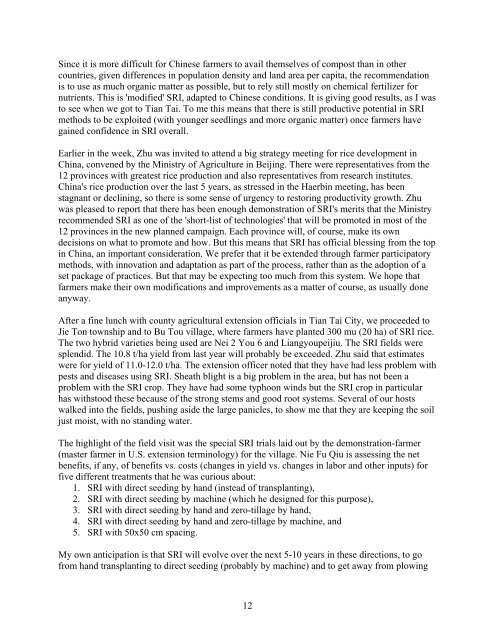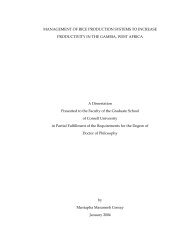Report from SRI China visit - The System of Rice Intensification ...
Report from SRI China visit - The System of Rice Intensification ...
Report from SRI China visit - The System of Rice Intensification ...
You also want an ePaper? Increase the reach of your titles
YUMPU automatically turns print PDFs into web optimized ePapers that Google loves.
Since it is more difficult for Chinese farmers to avail themselves <strong>of</strong> compost than in other<br />
countries, given differences in population density and land area per capita, the recommendation<br />
is to use as much organic matter as possible, but to rely still mostly on chemical fertilizer for<br />
nutrients. This is 'modified' <strong>SRI</strong>, adapted to Chinese conditions. It is giving good results, as I was<br />
to see when we got to Tian Tai. To me this means that there is still productive potential in <strong>SRI</strong><br />
methods to be exploited (with younger seedlings and more organic matter) once farmers have<br />
gained confidence in <strong>SRI</strong> overall.<br />
Earlier in the week, Zhu was invited to attend a big strategy meeting for rice development in<br />
<strong>China</strong>, convened by the Ministry <strong>of</strong> Agriculture in Beijing. <strong>The</strong>re were representatives <strong>from</strong> the<br />
12 provinces with greatest rice production and also representatives <strong>from</strong> research institutes.<br />
<strong>China</strong>'s rice production over the last 5 years, as stressed in the Haerbin meeting, has been<br />
stagnant or declining, so there is some sense <strong>of</strong> urgency to restoring productivity growth. Zhu<br />
was pleased to report that there has been enough demonstration <strong>of</strong> <strong>SRI</strong>'s merits that the Ministry<br />
recommended <strong>SRI</strong> as one <strong>of</strong> the 'short-list <strong>of</strong> technologies' that will be promoted in most <strong>of</strong> the<br />
12 provinces in the new planned campaign. Each province will, <strong>of</strong> course, make its own<br />
decisions on what to promote and how. But this means that <strong>SRI</strong> has <strong>of</strong>ficial blessing <strong>from</strong> the top<br />
in <strong>China</strong>, an important consideration. We prefer that it be extended through farmer participatory<br />
methods, with innovation and adaptation as part <strong>of</strong> the process, rather than as the adoption <strong>of</strong> a<br />
set package <strong>of</strong> practices. But that may be expecting too much <strong>from</strong> this system. We hope that<br />
farmers make their own modifications and improvements as a matter <strong>of</strong> course, as usually done<br />
anyway.<br />
After a fine lunch with county agricultural extension <strong>of</strong>ficials in Tian Tai City, we proceeded to<br />
Jie Ton township and to Bu Tou village, where farmers have planted 300 mu (20 ha) <strong>of</strong> <strong>SRI</strong> rice.<br />
<strong>The</strong> two hybrid varieties being used are Nei 2 You 6 and Liangyoupeijiu. <strong>The</strong> <strong>SRI</strong> fields were<br />
splendid. <strong>The</strong> 10.8 t/ha yield <strong>from</strong> last year will probably be exceeded. Zhu said that estimates<br />
were for yield <strong>of</strong> 11.0-12.0 t/ha. <strong>The</strong> extension <strong>of</strong>ficer noted that they have had less problem with<br />
pests and diseases using <strong>SRI</strong>. Sheath blight is a big problem in the area, but has not been a<br />
problem with the <strong>SRI</strong> crop. <strong>The</strong>y have had some typhoon winds but the <strong>SRI</strong> crop in particular<br />
has withstood these because <strong>of</strong> the strong stems and good root systems. Several <strong>of</strong> our hosts<br />
walked into the fields, pushing aside the large panicles, to show me that they are keeping the soil<br />
just moist, with no standing water.<br />
<strong>The</strong> highlight <strong>of</strong> the field <strong>visit</strong> was the special <strong>SRI</strong> trials laid out by the demonstration-farmer<br />
(master farmer in U.S. extension terminology) for the village. Nie Fu Qiu is assessing the net<br />
benefits, if any, <strong>of</strong> benefits vs. costs (changes in yield vs. changes in labor and other inputs) for<br />
five different treatments that he was curious about:<br />
1. <strong>SRI</strong> with direct seeding by hand (instead <strong>of</strong> transplanting),<br />
2. <strong>SRI</strong> with direct seeding by machine (which he designed for this purpose),<br />
3. <strong>SRI</strong> with direct seeding by hand and zero-tillage by hand,<br />
4. <strong>SRI</strong> with direct seeding by hand and zero-tillage by machine, and<br />
5. <strong>SRI</strong> with 50x50 cm spacing.<br />
My own anticipation is that <strong>SRI</strong> will evolve over the next 5-10 years in these directions, to go<br />
<strong>from</strong> hand transplanting to direct seeding (probably by machine) and to get away <strong>from</strong> plowing<br />
12
















